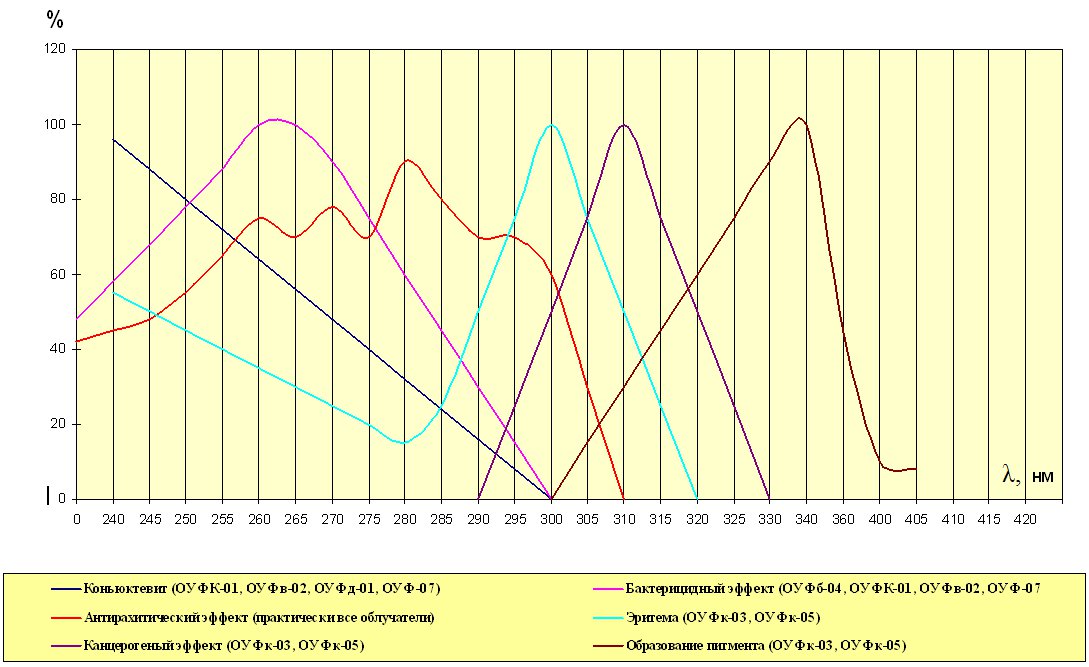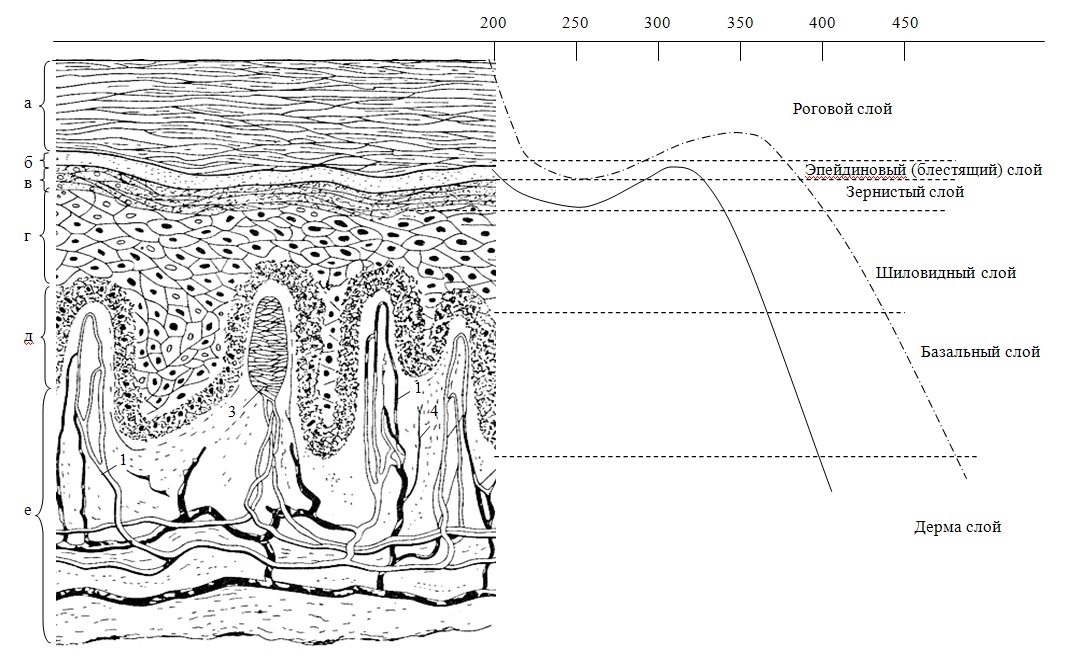Solnyshko Company is a developer and manufacturer of ultraviolet irradiators used in medical institutions and at home: OUFd-01, OUFK-01, OUFV-02, OUFD-01, OUFk-320 / 400-03, OUFB-04, OUFK-05, OUFb- 08, OUF-06, AMNP-02, DMV-02. Medical devices Solnyshko are used in UHF and UV therapy.
Therapeutic uses of ultraviolet radiation.

There are significant differences in the action of long, medium and short-wave radiation on cells, tissues and the body.
Area A (UV-A) long-wave radiation has a variety of biological effects, causes skin pigmentation and fluorescence of organic substances. UV-A rays have the highest penetrating power, which allows some atoms and molecules of the body to selectively absorb the energy of UV radiation and go into an unstable excited state. The subsequent transition to the initial state is accompanied by the release of light quanta (photons) capable of initiating various photochemical processes, primarily affecting DNA, RNA, and protein molecules.
Phototechnical processes cause reactions and changes on the part of various organs and systems, which form the basis of the physiological and therapeutic effect of UV rays. The shifts and effects occurring in an organism irradiated with UV rays (photoerythema, pigmentation, desensitization, bactericidal effect, etc.) have a clear spectral dependence (Fig. 1), which serves as the basis for the differentiated use of various sections of the UV spectrum.

Figure 1 – Spectral dependence of the most important biological effects of ultraviolet radiation
Irradiation with medium-wave UV rays causes photolysis of the protein with the formation of biologically active substances, and exposure to short-wave rays often leads to coagulation and denaturation of protein molecules. Under the influence of UV rays of the B and C ranges, especially in high doses, changes occur in nucleic acids, resulting in cell mutations.
At the same time, long-wavelength rays lead to the formation of a specific photoreactivation enzyme that promotes the recovery of nucleic acids.
- The most widely used UV radiation is for therapeutic purposes.
- UV rays are also used to sterilize and disinfect water, air, rooms, objects, etc.
- Their use for preventive and cosmetic purposes is very common.
- UV radiation is also used for diagnostic purposes, to determine the reactivity of the organism, in luminescent methods.
UV radiation is a vital factor, and its prolonged lack leads to the development of a kind of symptom complex, which has "light starvation" or "UV deficiency". Most often, it is manifested by the development of avitaminosis D, weakening of the protective immunobiological reactions of the body, exacerbation of chronic diseases, functional disorders of the nervous system, etc.e. The contingents experiencing "UV deficiency" include workers in mines, mines, metro, people working in lanternless and windowless workshops, engine rooms and in the Far North.
ultraviolet irradiation
Ultraviolet irradiation is produced by various artificial products with different wavelengths λ. The absorption of UV rays is accompanied by a number of primary photochemical and photophysical processes, which depend on their spectral composition and determine the physiological and therapeutic effect of the factor on the body.
Longwave ultraviolet (DUV) rays stimulate the proliferation of cells of the malpighian layer of the epidermis and the decarboxylation of tyrosine, followed by the formation of a spiny layer in the cells. Next comes the stimulation of the synthesis of ACTH and other hormones, etc. Various immunological changes are obtained.
DUV rays have a weaker biological effect than other UV rays, including the erythema-forming effect. To enhance the sensitivity of the skin to them, photosensitizers are used, most often compounds of the furocoumarin series (puvalen, beroxan, psoralen, amminofurin, etc.)
This property of long-wave radiation allows it to be used in the treatment of skin diseases. PUVA therapy method (salicylic alcohol is also used).
Thus, we can highlight the main characteristics of the therapeutic effects of UV rays:
Therapeutic effects are:
- photosensitizing
- pigment-forming,
- immunostimulating.
1. UV rays, like other areas of UV radiation, cause a change in the functional state of the central nervous system and its higher part of the cerebral cortex. Due to the reflex reaction, blood circulation improves, the sectoral activity of the digestive organs and the functional state of the kidneys increase.
2. UV rays affect metabolism, primarily mineral and nitrogen.
3. Local applications of photosensitizers are widely used for limited forms of psoriasis. Recently, UV-B has been successfully used as a sensitizer as it has a greater biological activity. The combined exposure of UV-A and UV-B is called selective exposure.
4. UV rays are used for both local and general exposures. The main indications for their use are:
- skin diseases (psoriasis, eczema, vitiligo, seborrhea, etc.)
- chronic inflammatory diseases of the internal organs (especially the respiratory organs)
- diseases of the organs of support and movement of various ethnologies
- burns, frostbite
- sluggish wounds and ulcers, cosmetic purposes.
Contraindications
- acute anti-inflammatory processes,
- diseases of the liver and kidneys with a pronounced violation of their functions,
- hyperthyroidism,
- increased sensitivity to UV radiation.
medium wave ultraviolet (SUV) radiation has a pronounced and versatile biological effect.
When UV radiation quanta are absorbed in the skin, low molecular weight products of protein photolysis and products of lipid peroxidation are formed. They cause changes in the ultrastructural organization of biological membranes, protein-lipid complexes, membrane enzymes and their most important physicochemical and functional properties.
Photodegradation products activate the system of mononuclear phagocytes and cause degranulation of mastocytes and basophils. As a result, biologically active substances (kinin, prostaglandin, heparin, leukotrienes, thromboxanes, etc.) and vasoactive mediators (acetylcholine, histamine) are released in the irradiated area and adjacent tissues, which significantly increase vascular permeability and tone, and also help to relax smooth muscles. . Due to humoral mechanisms, the number of functioning capillaries of the skin increases, the rate of local blood flow increases, which leads to the formation of erythoma.
Repeated UV exposure can lead to the appearance of rapidly disappearing pigmentation, which enhances the barrier function of the skin, increases its cold sensitivity and resistance to the action of toxic substances and adverse factors.
Both the erythema response and other shifts induced by UV rays depend not only on the wavelength, but also on the dosage. In phototherapy, it is used in erythemal and suberythemal doses.
Exposure to suberythemal doses of UV rays promotes the formation of vitamin D in the skin, which, after its biotransformation in the liver and kidneys, is involved in the regulation of phosphorus-calcium metabolism in the body. UV irradiation contributes to the formation of not only vitamin D1, but also its isomer, ergocalcifemin (vitamin D2). The latter has an antirachitic effect, stimulates the aerobic and anaerobic pathways of cellular respiration. SUV rays in small doses also modulate the metabolism of other vitamins (A and C) and cause activation of metabolic processes in irradiated tissues. Under their influence, the adaptive-trophic function of the sympathetic nervous system is activated, the disturbed processes of various types of metabolism and cardiovascular activity are normalized.
Thus, UV radiation has a pronounced biological effect. Depending on the phase of irradiation, erythema on the skin and mucous membranes can be obtained or treated at a dose that does not cause it. The mechanism of therapeutic action of erythemal and non-erythemal doses of SUV is different, therefore, the indications for the use of ultraviolet radiation will also be different.
Ultraviolet erythema appears at the site of UV-B irradiation after 2-8 hours and is associated with the death of epidermal cells. The products of protein photolysis enter the blood stream and cause vasodilation, skin edema, migration of leukocytes, irritation of numerous receptors, leading to a number of reflex reactions of the body.
In addition, the products of photolysis entering the blood stream have a humoral effect on individual organs, the nervous and endocrine systems of the body. The phenomena of aseptic inflammation gradually subside by the seventh day, leaving behind skin pigmentation at the site of irradiation.
The main therapeutic effects of UV radiation:
- SUV – radiations are vitamin-forming, trophostimulating, immunomodulatory – these are suberythemal doses.
- Anti-inflammatory, analgesic, desensitizing – this is the erythemal dose.
- Bronchial diseases, asthma, hardening – this is an erythema-free dose.
Indications for topical use of UV-B (suberythemal and erythemal doses):
- acute neuritis
- acute meositis
- pustular skin diseases (furucle, carbuncle, sycosis, etc.)
- erysipelas
- trophic ulcers
- sluggish wounds
- bedsores
- inflammatory and post-traumatic diseases of the joints
- rheumatoid arthritis
- bronchial asthma
- acute and chronic bronchitis
- acute respiratory diseases
- inflammation of the uterine appendages
- chronic tonsillitis.
Erythema-free zones of ultraviolet radiation of spectrum B during general irradiation of the body eliminate the effects of D-hypovitaminosis associated with a lack of sunlight. It normalizes phosphorus-calcium metabolism, stimulates the function of the sympathetic-adrenal and pituitary-adrenal systems, increases the mechanical strength of bone tissue and stimulates the formation of callus, increases the resistance of the skin of the body and the body as a whole to harmful environmental factors. Allergic and exudative reactions decrease, mental and physical performance increases. Other disorders in the body caused by solar starvation are weakened.
Indications for general use of UV-B (erythema-free doses):
- D-hypovitaminosis
- metabolic disease
- predisposition to pustular diseases
- neurodermatitis
- psoriasis
- bone fractures and impaired callus formation
- bronchial asthma
- chronic diseases of the bronchial apparatus
- hardening of the body.
Contraindications:
- malignant neoplasms
- tendency to bleed
- systemic blood diseases
- thyrotoxicosis
- active tuberculosis
- peptic ulcer of the stomach and duodenum in the acute stage
- hypertension stage II and III
- advanced atherosclerosis of the arteries of the brain and coronary arteries.
Shortwave ultraviolet radiation spectrum (UV) radiation.
UV radiation of the short-wave range is an active physical factor, since its quanta have the largest energy reserve. It is capable of causing denaturation and photolysis of nucleic acids and proteins due to excessive absorption of the energy of its quanta by various molecules, primarily DNA and RNA.
When acting on microorganisms, on cells, this leads to inactivation of their genome and protein denaturation, which leads to their death.
When radiation, the cof rays occurs a bactericidal effect, since the direct hit of their protein is disliked for viruses, microorganisms and mushrooms.
Couff rays cause an expansion of blood vessels after a short spasm, primarily subcakely veins.
Indications for the use of Couff radiation:
- Irradiation of wound surfaces
- Prolesidery and almond niches after tonsillectomine with bactericidal chain
- Sanitation of nasopharynx during acute painting diseases
- Treatment of outdoor otitis
- Disinfection of air in operating, procedural, inhalers, resuscitation branches, patient chambers, children's institutions and schools.
Skin and its function
Man's skin is 18% of human body weight and has a total area of 2m2. Consists of three anatomically and physiologically closely interconnected layers:
- Epidermis or supercoke
- Derma (actually skin)
- Hydrometer (subcutaneously fat lining).
The epidermis is constructed from various shape and structure, layers of epithelial cells (epithermcites). At the same time, each overlay cell occurs from the underlying, reflecting a certain phase of its life.
The layers of the epidermis are located in the following sequence (bottom-up):
- basal (e) or germ;
- a layer of spiked cells;
- layer of keratogial or granular cells;
- epeidine or brilliant;
- horny.
In addition to epidermocytes in the epidermis (in the basal layer), cells are located capable of producing melanin (melanocytes), Lagergans, Greensyne cells, etc.
The dermis is located directly under the epidermis and is separated from it the main membrane. The dermis distinguishes the papilla and mesh layers. It consists of collagen, elastic and reticulin (argirophilic) fibers, between which is located the main substance.
In the dermis, in fact, there is a puffing layer in the skin, richly equipped with blood and lymphatic vessels. There are also plexus of nerve fibers, giving rise to numerous nervous endings in the epidermis and dermis. In the dermis are laid at various levels of sweat and sebaceous glands, hair follicles.
Subcutaneous fatty fiber is the deepest layer of skin.
Skin features are complex and diverse. The skin performs the barrier – protective, thermostat, excretory, exchange, receptor, etc.
Barrier – a protective function that is considered to be the main function of human and animal skin, is carried out at the expense of various mechanisms. Thus, the durable and elastic horny layer of the skin is opposed by mechanical influences and reduces the harmful effect of chemicals. The horny layer, being a bad conductor, protects the flowing layers from drying, cooling and operation of the electric current.

Figure 2 – Skin structure
Skin fat, the product secretion of sweat glands and flakes of the exfoliating epithelium form on the surface of the skin emulsion film (protective mantle), which plays an important role in the protection of the skin from the impact of chemical, biological and physical agents.
The acid reaction of the water-lipid mantle and the surface layers of the skin, as well as the bactericidal properties of the skin secretion, are an important barrier mechanism for microorganisms.
The pigment melanin plays a role in protecting against light rays.
The electrophysiological barrier is the main obstacle to the penetration of substances deep into the skin, including during electrophoresis. It is located at the level of the basal layer of the epidermis and is an electrical layer with heterogeneous layers. The outer layer, due to the acid reaction, has a “+” charge, and the inwardly facing “-”. It should be borne in mind that, on the one hand, the barrier-protective function of the skin weakens the effect of physical factors on the body, and on the other hand, physical factors can stimulate the protective properties of the skin and thereby realize a therapeutic effect.
Physical thermoregulation body is also one of the most important physiological functions of the skin and is directly related to the mechanism of action of hydrotherapy factors. It is carried out by the skin by heat radiation in the form of infrared rays (44%), heat conduction (31%) and water evaporation from the skin surface (21%). It is important to note that the skin with its thermoregulatory mechanisms plays an important role in the acclimatization of the body.
Secret-excretory function skin is associated with the activity of sweat and sebaceous glands. It plays an important role in maintaining the homeostasis of the body, in the performance of skin barrier properties.
Respiratory and resorption function are closely interconnected. The respiratory function of the skin, consisting in the absorption of oxygen and the release of carbon dioxide, is of little importance in the overall balance of respiration for the body. However, respiration through the skin can increase significantly in conditions of high air temperature.
The resorption function of the skin, its permeability are of great importance not only in dermatology and toxicology. Its significance for physiotherapy is determined by the fact that the chemical component of the action of many therapeutic factors (medicinal, gas and mineral baths, mud therapy, etc.) depends on the penetration of their constituent ingredients through the skin.
exchange function skin has specific features. On the one hand, only its inherent metabolic processes occur in the skin (the formation of keratin, melanin, vitamin D, etc.), on the other hand, it takes an active part in the general metabolism in the body. Its role in fat, mineral, carbohydrate and vitamin metabolism is especially great.
The skin is also a site for the synthesis of biologically active substances (heparin, histamine, serotonin, etc.).
Receptor function skin provides its connection with the external environment. The skin performs this function in the form of numerous conditioned and unconditioned reflexes due to the presence in it of the various receptors mentioned above.
It is believed that there are 100-200 pain points per 1 cm 2 of skin, 12-15 cold, 1-2 heat, 25 pressure points.
Relationship with internal organs closely related – skin changes affect the activity of internal organs, and violations of the internal organs are accompanied by shifts in the skin. This relationship is especially clearly manifested in internal diseases in the form of the so-called reflexogenic, or painful, Zakharin-Ged zones.
Zakharyin-Geda zone certain areas of the skin, in which, in diseases of the internal organs, reflected pain often appears, as well as pain and temperature hyperesthesia.

Figure 3 – Location of the Zakharyin-Ged zone
1 Lungs and bronchi;
4 Bladder;
8 Stomach, pancreas
10 Genitourinary system
Such zones in diseases of the internal organs were also found in the head area. For example, pain in the fronto-nasal region corresponds to the defeat of the tops of the lungs, stomach, liver, aortic mouth.
pain in the mid-eye region damage to the lungs, heart, ascending aorta.
pain in the frontotemporal region damage to the lungs and heart.
pain in the parietal region damage to the pylorus and upper intestine, etc.
Comfort zone the area of temperature conditions of the external environment, causing a subjectively good heat sensation in a person without signs of cooling or overheating.
For a naked person 17.3 o C – 21.7 o C
For a dressed person 16.7 o C – 20.6 o C
Pulsed Ultraviolet Therapy
Research Institute of Energy Engineering, Moscow State Technical University. N. E. Bauman (Shashkovsky S. G. 2000) developed a portable device "Melitta 01" for local irradiation of the affected surfaces of skin coatings, mucous membranes with highly efficient pulsed continuous spectrum ultraviolet radiation in the range of 230-380 nm.
The operating mode of this device is pulse-periodic with a frequency of 1 Hz. The device provides automatic generation of 1, 4, 8, 16, 32 pulses. Output pulsed power density at a distance of 5 cm from the burner 25 W / cm 2
Indications:
- purulent-inflammatory diseases of the skin and subcutaneous tissue (furuncle, carbuncle, hydradenitis) in the initial period of hydration and after surgical opening of the purulent cavity;
- extensive purulent wounds, wounds after necrectomy, wounds before and after autodermoplasty;
- granulating wounds after thermal, chemical, radiation burns;
- trophic ulcers and sluggish wounds;
- erysipelas;
- herpetic inflammation of the skin and mucous membranes;
- irradiation of wounds before and after primary surgical treatment in order to prevent the development of purulent complications;
- disinfection of indoor air, car interior, bus and ambulance.
Pulse magnetic therapy with a rotating field and changing the frequency of repetition of impulses automatically.
The therapeutic effect is based on well-known physical laws. An electric charge moving through a blood vessel in a magnetic field is affected by the Lorentz force perpendicular to the charge velocity vector, constant in a constant and alternating sign in an alternating, rotating magnetic field. closely related – skin changes affect the activity of internal organs, and violations of the internal organs are accompanied by shifts in the skin. This relationship is especially clearly manifested in internal diseases in the form of the so-called reflexogenic, or painful, Zakharin-Ged zones.
Zakharyin-Geda zone
certain areas of the skin, in which, in diseases of the internal organs, reflected pain often appears, as well as pain and temperature hyperesthesia.
Figure 3 – Location of the Zakharyin-Ged zone
1 Lungs and bronchi;
4 Bladder;
- 8 Stomach, pancreas
- 10 Genitourinary system
- Such zones in diseases of the internal organs were also found in the head area. For example, pain
- in the fronto-nasal region
- corresponds to the defeat of the tops of the lungs, stomach, liver, aortic mouth.
- pain
- in the mid-eye region
- damage to the lungs, heart, ascending aorta.
- pain
- in the frontotemporal region
- damage to the lungs and heart.
pain
- in the parietal region
- damage to the pylorus and upper intestine, etc.
- Comfort zone
- the area of temperature conditions of the external environment, causing a subjectively good heat sensation in a person without signs of cooling or overheating.
- For a naked person 17.3 o C – 21.7 o C
- For a dressed person 16.7 o C – 20.6 o C
- Pulsed Ultraviolet Therapy
- Research Institute of Energy Engineering, Moscow State Technical University. N. E. Bauman (Shashkovsky S. G. 2000) developed a portable device "Melitta 01" for local irradiation of the affected surfaces of skin coatings, mucous membranes with highly efficient pulsed continuous spectrum ultraviolet radiation in the range of 230-380 nm.
- The operating mode of this device is pulse-periodic with a frequency of 1 Hz. The device provides automatic generation of 1, 4, 8, 16, 32 pulses. Output pulsed power density at a distance of 5 cm from the burner 25 W / cm 2
- Indications:
- purulent-inflammatory diseases of the skin and subcutaneous tissue (furuncle, carbuncle, hydradenitis) in the initial period of hydration and after surgical opening of the purulent cavity;
- extensive purulent wounds, wounds after necrectomy, wounds before and after autodermoplasty;
granulating wounds after thermal, chemical, radiation burns;
trophic ulcers and sluggish wounds;
erysipelas;

